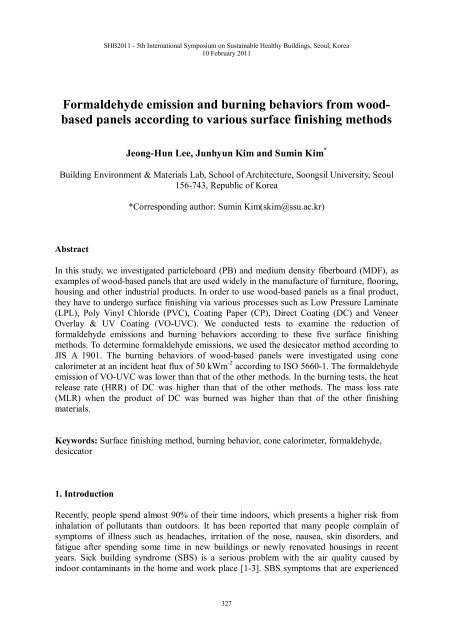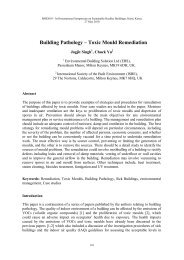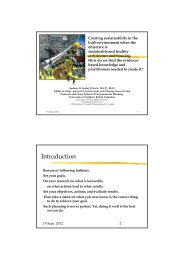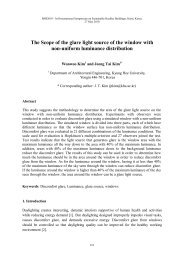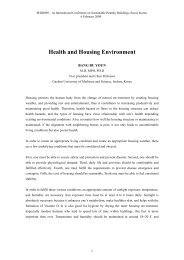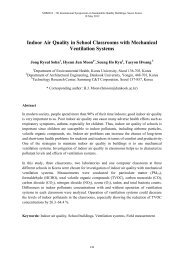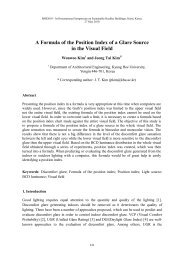Formaldehyde emission and burning behaviors from wood- based ...
Formaldehyde emission and burning behaviors from wood- based ...
Formaldehyde emission and burning behaviors from wood- based ...
Create successful ePaper yourself
Turn your PDF publications into a flip-book with our unique Google optimized e-Paper software.
SHB2011 - 5th International Symposium on Sustainable Healthy Buildings, Seoul, Korea10 February 2011<strong>Formaldehyde</strong> <strong>emission</strong> <strong>and</strong> <strong>burning</strong> <strong>behaviors</strong> <strong>from</strong> <strong>wood</strong><strong>based</strong>panels according to various surface finishing methodsJeong-Hun Lee, Junhyun Kim <strong>and</strong> Sumin Kim *Building Environment & Materials Lab, School of Architecture, Soongsil University, Seoul156-743, Republic of Korea*Corresponding author: Sumin Kim(skim@ssu.ac.kr)AbstractIn this study, we investigated particleboard (PB) <strong>and</strong> medium density fiberboard (MDF), asexamples of <strong>wood</strong>-<strong>based</strong> panels that are used widely in the manufacture of furniture, flooring,housing <strong>and</strong> other industrial products. In order to use <strong>wood</strong>-<strong>based</strong> panels as a final product,they have to undergo surface finishing via various processes such as Low Pressure Laminate(LPL), Poly Vinyl Chloride (PVC), Coating Paper (CP), Direct Coating (DC) <strong>and</strong> VeneerOverlay & UV Coating (VO-UVC). We conducted tests to examine the reduction offormaldehyde <strong>emission</strong>s <strong>and</strong> <strong>burning</strong> <strong>behaviors</strong> according to these five surface finishingmethods. To determine formaldehyde <strong>emission</strong>s, we used the desiccator method according toJIS A 1901. The <strong>burning</strong> <strong>behaviors</strong> of <strong>wood</strong>-<strong>based</strong> panels were investigated using conecalorimeter at an incident heat flux of 50 kWm -2 according to ISO 5660-1. The formaldehyde<strong>emission</strong> of VO-UVC was lower than that of the other methods. In the <strong>burning</strong> tests, the heatrelease rate (HRR) of DC was higher than that of the other methods. The mass loss rate(MLR) when the product of DC was burned was higher than that of the other finishingmaterials.Keywords: Surface finishing method, <strong>burning</strong> behavior, cone calorimeter, formaldehyde,desiccator1. IntroductionRecently, people spend almost 90% of their time indoors, which presents a higher risk <strong>from</strong>inhalation of pollutants than outdoors. It has been reported that many people complain ofsymptoms of illness such as headaches, irritation of the nose, nausea, skin disorders, <strong>and</strong>fatigue after spending some time in new buildings or newly renovated housings in recentyears. Sick building syndrome (SBS) is a serious problem with the air quality caused byindoor contaminants in the home <strong>and</strong> work place [1-3]. SBS symptoms that are experienced327
SHB2011 - 5th International Symposium on Sustainable Healthy Buildings, Seoul, Korea10 February 2011Table 1. The characteristics of various surface finishing methods.Classification MethodReference panel UntreatedLow Pressure Saturating papers are cured on panel surface using hot press processLaminates LPL)Poly Vinyl PVC films are cured on panel surface at room temperature usingChloride (PVC) EVA(Ethylene Vinyl Acetate) resinCoating Paper The paper with resin coating cured on panel surface at room(CP)temperature using PVAC resinDirect Coating Polyester resin cured on panel surface using hot process or infrared(DC)Veneer Overlay Veneer overlay(0.2~0.6mm) glued on panel surface with PVAC or& UV Coating urea resin <strong>and</strong> cured using irradiation of UV(VO-UVC)2.2. Test method2.2.1. <strong>Formaldehyde</strong> <strong>emission</strong> by desiccator methodThe formaldehyde <strong>emission</strong>s <strong>from</strong> the MDF <strong>and</strong> PB were determined according to the JISmethod (JIS A 1460) using a glass desiccator. The 24-h desiccator method uses a common,10L glass desiccator with a volume. The <strong>emission</strong> test lasted 24 h in the covered desiccator ata temperature of 20°C. Samples of the non-edge sealed <strong>and</strong> edge sealed by three sealingmethods all underwent testing. The emitted quantity of formaldehyde was obtained <strong>from</strong> theconcentration of formaldehyde absorbed in a Petri dish filled with a specified amount ofdistilled or deionized water. The absorbed formaldehyde was analyzed by using thechromotropic acid method. The principle for determining the concentration of formaldehydeabsorbed in the distilled or deionized water is <strong>based</strong> on the Hantzsch reaction in which theformaldehyde reacts with ammonium ions <strong>and</strong> acetylacetone to yield diacetyldihydrolutidine.For each of the <strong>emission</strong> tests, the three different grades of the MDF <strong>and</strong> PB specimens weretested: E0, E1 <strong>and</strong> E2. As a reference test, MDF <strong>and</strong> PB specimens without surface finishingtreatment were tested in addition to the other specimens with the five surface finishingtreatments, giving a total of 36 experimental specimens.2.2.2 Cone calorimeterThe cone calorimeter is recognized worldwide as one of the most acceptable fire testingapparatuses. Fig. 1 presents a schematic view of the cone calorimeter. To confirm the <strong>burning</strong>behavior of the panels, specimens of dimensions 100mm x 100mm x 18 mm thickness werefabricated. The experimental results were calculated <strong>based</strong> on the average of threeexperimental data for each test.All the experiments were conducted by placing the specimens in the same holder in ahorizontal position under the cone heater with 50kWm-2 of heat flux. In the cone calorimeter329
SHB2011 - 5th International Symposium on Sustainable Healthy Buildings, Seoul, Korea10 February 2011test, the heat release rate (HRR), total heat rate <strong>and</strong> mass loss rate (MLR) were investigated.The cone calorimeter test was conducted according to ISO-5660-1 st<strong>and</strong>ard.Fig. 1. Schematic diagram of the cone calorimeter.3. Results <strong>and</strong> discussion3.1 <strong>Formaldehyde</strong> <strong>emission</strong>To confirm the formaldehyde <strong>emission</strong> in accordance with the six surface finishing methods,the panels were tested by the simple <strong>and</strong> inexpensive desiccator method, as defined in KS F3104 <strong>and</strong> KS F 3200, which are similar to JIS A 1460 (Building boards determination offormaldehyde <strong>emission</strong>-desiccator method).For the MDF panels, the <strong>emission</strong>s of the E0 grade (1.5mg/L), there was clear variation among the six specimens. The DC <strong>and</strong> VO-UVC <strong>emission</strong>s were lower than the reference value, by approximately 20% for the latter. Fig.2 shows the formaldehyde <strong>emission</strong>s of the MDF specimens.330
SHB2011 - 5th International Symposium on Sustainable Healthy Buildings, Seoul, Korea10 February 2011To summarize these <strong>emission</strong> test results, the DC <strong>and</strong> VO-UVC methods showed the lowest<strong>emission</strong> levels regardless of the natural <strong>emission</strong> grade of product. Unlike other methodsinvolving room temperature curing, the DC method includes hot or infrared curing <strong>and</strong> theVO-UVC method includes UV irradiation curing. This explains that the free formaldehydedecomposition <strong>and</strong> reduction in the curing process. However, the LPL method, whichincludes a hot pressing process for curing, showed different <strong>behaviors</strong>.3.2 Burning <strong>behaviors</strong>To determine the variations of <strong>burning</strong> behavior among the six surface finishing methods, the<strong>burning</strong> <strong>behaviors</strong> were investigated using a cone calorimeter. Only E2 grade specimens wereused in the cone calorimeter test. The cone calorimeter is a performance-<strong>based</strong>, bench scale,fire-testing apparatus that provides comprehensive insight into not only fire risks such as (Edthisacronym has already been defined above) HRR, total heat release (THR), <strong>and</strong> time toignition, but also fire hazards such as smoke release <strong>and</strong> CO production. However, in thisstudy the cone calorimeter was conducted to test <strong>and</strong> confirm the fire risks according to thesurface finishing methods.The FR <strong>and</strong> <strong>burning</strong> <strong>behaviors</strong> were evaluated with a heat flux of 50kWm -2 over a totalduration <strong>from</strong> complete installation of the specimen until the flame was turned off. The HRR<strong>and</strong> MLR of PB <strong>and</strong> MDF according to each surface finishing method are shown in Figs. 4<strong>and</strong> 5.300MDF300PB250200ReferencepanelLPL250200ReferencepanelLPLHRR (kW/m 2 )15010050PVCCoating PaperDirect CoatingHRR (kW/m 2 )15010050PVCCoating PaperDirect Coating00 250 500 750 1000 1250 1500-50Time(s)Veneer Overlay+ UV Coating00 250 500 750 1000 1250 1500-50Time(s)Fig. 4. HRR of MDF <strong>and</strong> PB for the six surface finishing methodsVeneer Overlay+ UV CoatingFig. 5. MLR of MDF <strong>and</strong> PB for the six surface finishing methods332
SHB2011 - 5th International Symposium on Sustainable Healthy Buildings, Seoul, Korea10 February 2011The DC method showed higher HRR for both MDF <strong>and</strong> PB than the other specimens.However, the MDF <strong>and</strong> PB specimens showed similar patterns regardless of the surfacefinishing method with only negligible differences. MLR showed a similar trend to that ofHRR. (Ed- this sentence is unnecessary as you’ve already stated the same in the previoussentence)The THR results are shown in Fig.6. The DC method showed the highest values for bothMDF <strong>and</strong> PB. Generally, in the cone calorimeter test, the HRR <strong>and</strong> THR of MDF were higherthan those of PB.Fig. 6. THR of MDF <strong>and</strong> PB for the six surface finishing methods4. ConclusionThe formaldehyde <strong>emission</strong>s <strong>and</strong> <strong>burning</strong> <strong>behaviors</strong> of PB <strong>and</strong> MDF, which are commonlyused as furnishing materials, were evaluated as a function of six different surface finishingmethods.The formaldehyde <strong>emission</strong>s for the E2 grade specimens varied significantly among the sixsurface finishing methods. The DC <strong>and</strong> VO-UVC methods were the most effective overall inreducing formaldehyde <strong>emission</strong>s. Thus, pollutants emitted by <strong>wood</strong>-<strong>based</strong> boards can bereduced by changing the surface finish method. However, the formaldehyde <strong>emission</strong>s of theLPL specimens far <strong>from</strong> reduction despite the absence of any adhesives <strong>and</strong> the inclusion of ahot press curing process. This is greatly different <strong>from</strong> the basic concept which formaldehyde<strong>emission</strong> shielding <strong>from</strong> the surface of <strong>wood</strong>-<strong>based</strong> products would significantly decrease theoverall <strong>emission</strong>s.The combustion <strong>and</strong> fire resistance varied slightly according to the surface finishing type.The initial HRR was slightly higher for DC than for the other surface finishing types.However, the difference was negligible. In comparison with a previous study <strong>and</strong> otherinterior materials the panel specimens retained higher initial HRR <strong>and</strong> THR, indicating thatthe fire resistance or FR retardant performance cannot be guaranteed for only surfacetreatment. Thus, to grant FR performance the other methods should be designed <strong>and</strong>conducted the test to confirm the <strong>burning</strong> <strong>behaviors</strong>.333
SHB2011 - 5th International Symposium on Sustainable Healthy Buildings, Seoul, Korea10 February 2011AcknowledgementsThis research was supported by Basic Science Research Program through the NationalResearch Foundation of Korea (NRF) funded by the Ministry of Education, Science <strong>and</strong>Technology (No. 2010-0001860).References[1] Hodgson, M. (2002) Indoor environmental exposures <strong>and</strong> symptoms. Environ. HealthPerspect. 110(4), 663-667.[2] Menzies, D., Bourbeau, J. (1997) Building related illnesses. New Eng. J. Med. 337, 1524-1531.[3] Lee, S.-W., Yang, Y.-S., Ahn, T.-H., Bae, C.-S., Moon, C.-J., Kim, S.-H., Song, S.-Y.,Hwang, H.-Z., Kim, J.-C. (2007) Subacute toxicity evaluation in rats exposed to concrete<strong>and</strong> hwangto building environments. Environ. Toxicol. 22(3), 264-274.[4] Franck C. Eye symptoms <strong>and</strong> signs in buildings with indoor climate problems ('OfficeEye Syndrome'). Acta Ophthalmologica 1986;64:306-11.[5] Kjærgaard SK, Pedersen OF, Taudorf E, Mølhave L. Assessment of changes in eyeredness by a photographic method <strong>and</strong> the relation to sensory eye irritation. InternationalArchives of Occupational <strong>and</strong> Environmental Health 1990;62:133-7.[6] Andersson K, Bakke JV, Bjorseth O, Bornehag CG, Clausen G, Hongslo JK, et al. TVOC<strong>and</strong> health in non-industrial indoor environments. Indoor Air 1997;7:78-91.[7] Choi DW, Moon KW, Byeon SH, Lee EI, Sul DG, Lee JH, et al. Indoor volatile organiccompounds in atopy patients' houses in South Korea. Indoor <strong>and</strong> Built Environment2009;18:144-54.[8] James JP, Yang X. Emissions of volatile organic compounds <strong>from</strong> several green <strong>and</strong> nongreenbuilding materials: a comparison. Indoor <strong>and</strong> Built Environment 2005;14:69-74.[9] Zhang Y, Xu Y. Characteristics <strong>and</strong> correlations of VOC <strong>emission</strong>s <strong>from</strong> buildingmaterials. International Journal of Heat <strong>and</strong> Mass Transfer 2003;46 (25):4877-83.[10] P.K. Kawouras, D. Koniditsiotis <strong>and</strong> J. Petinarakis, Resistance of cured ureaformaldehyderesins to hydrolysis, Holzforschung 52 (1998), pp. 105–110.[11] R. Vansteenkiste, Surface treatment of <strong>wood</strong> <strong>based</strong> panels, Seminar on Wood BasedPanels <strong>and</strong> Furniture Industries, Beijing, China, 1981.[12] S. Kim <strong>and</strong> H.-J. Kim, Anti-bacterial performance of colloidal silver-treated laminate<strong>wood</strong> flooring, Int. Biodeterior. Biodegrad. 57 (2005), pp. 155–162.[13] G. Nemli <strong>and</strong> G. Çolakog lu, The influence of lamination technique on the properties ofparticleboard, Build. Environ. 40 (2005), pp. 83–87.[14] A. Grigoriou, <strong>Formaldehyde</strong> <strong>emission</strong> <strong>from</strong> the edges <strong>and</strong> faces of various <strong>wood</strong> <strong>based</strong>materials, Holz Roh Werkst. 45 (1987), pp. 63–67.[15] Ondrej Grexa, Franck Poutch, Desana Manikova, Helena Martvonova <strong>and</strong> AndreaBartekova, Intumescence in fire retardancy of lignocellulosic panels, Polymer Degradation<strong>and</strong> Stability Volume 82, Issue 2, 2003, Pages 373-377334


